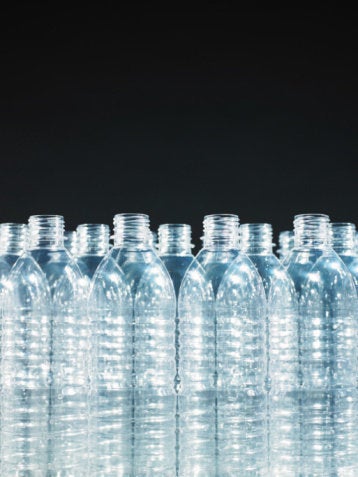
The past several of years have brought many "new" discoveries about the problem of plastic in the ocean and the associated problems for animals and humans. We are told that scientists have discovered that there are vast areas of the ocean swarming with small plastic particles, a continent-sized bowl of plastic soup. These "Great Garbage Patches" are known from both the Atlantic and Pacific Oceans.
We've also learned that bits of plastic in coastal waters can attract bacteria and absorb polychlorinated biphenyls. These toxic packets of plastic are then eaten by a wide variety of fish. In turn, eaten by us.
While these findings are shocking and require our immediate attention and action, even more surprising is that they were first published nearly 40 years ago in the prestigious journal Science by researchers at Wood's Hole Oceanographic Institution.
These researchers described the accumulation of concerning levels of plastic particles at sea, along our shores and chemical contamination of ocean animals in great detail (see references below).
So, why wasn't there a response? One of my colleagues suggested that the public wasn't "ready" to deal with plastic pollution in 1972.
But as I recall, the public was VERY ready. So ready that they founded Earth Day forty years ago in 1970 and twenty million Americans took to the streets and parks in thousands of schools and communities to celebrate environmental stewardship. That's 10 percent of the population!
Massive Earth Day demonstrations combined with top-notch peer reviewed science from our leading ocean research institutions should lead to some kind of action, right?
Instead, plastic production, use of single-use disposable plastic and plastic pollution grew exponentially. The plastics industry stepped on the gas, hired lobbyists and marketers and did their thing. Profits from plastics soared. Life became more "convenient".
Forty years later plastic pollution isn't so much a new idea but a worsening old problem, much, much worse.
Now, we have no choice, our solutions and responses must be drastic.
We gave plastic and those who manufacture, sell and use it (all of us) complete freedom to run wild and decide for ourselves what was responsible. And we did. In return we got "convenience." And many generations into the future people will inconveniently be dealing with the mess we've made.
Forty years ago our best science told us we had a serious, growing problem on our hands, but we ignored it. At that juncture, it could have been addressed.
Now, it's abundantly clear that plastic needs a time out. Maybe a very long one.
Recycling clearly hasn't worked. And most plastics can only be down-cycled. Toxicologists tell us that the stuff in some plastics can mess with our hormones. So, we are faced with the urgent need to drastically reduce our consumption of single use disposable plastics. In response, taxes, bans, and plastic-free businesses are popping up around the world.
Activists and scientists are using every form of media and educational outlet available to get the word out. Some are conducting elaborate eco-stunts to grab headlines. And lawyers and legislators are navigating rules and regulations along their tedious path to law and policy.
We are painfully slow on this eco stuff. But it's not just because we're not "ready" for action. The fact is that hundreds of millions of dollars have been spent to convince us that there is no problem, that the cost in pollution is worth the convenience, and to direct our attention to the middle of the ocean or to confuse us about the real solutions.
Here's the problem: plastic has misbehaved and plastic pollution is now everywhere.
Here's the solution: plastic needs a time out, cut as much plastic from your life as you can and support legislation that limits its use.
Now.
Plastic pollution research from the 1970's:
Science 17 November 1972:Vol. 178. no. 4062, pp. 749 - 750DOI: 10.1126/science.178.4062.749
Polystyrene Spherules in Coastal Waters
Edward J. Carpenter 1, Susan J. Anderson 1, George R. Harvey 1, Helen P. Miklas 1, and Bradford B. Peck 1
1 Woods Hole Oceanographic Institution, Woods Hole, Massachusetts 02543
Polystyrene spherules averaging 0.5 millimeter in diameter (range 0.1 to 2 millimeters) are abundant in the coastal waters of southern New England. Two types are present, a crystalline (clear) form and a white, opaque form with pigmentation resulting from a diene rubber. The spherules have bacteria on their surfaces and contain polychlorinated biphenyls, apparently absorbed from ambient seawater, in a concentration of 5 parts per million. White, opaque spherules are selectively consumed by 8 species of fish out of 14 species examined, and a chaetognath. Ingestion of the plastic may lead to intestinal blockage in smaller fish.
Science 17 March 1972:Vol. 175. no. 4027, pp. 1240 - 1241DOI: 10.1126/science.175.4027.1240
Plastics on the Sargasso Sea Surface
Edward J. Carpenter 1 and K. L. Smith Jr. 1
1 Woods Hole Oceanographic Institution, Woods Hole, Massachusetts 02543
Plastic particles, in concentrations averaging 3500 pieces and 290 grams per square kilometer, are widespread in the western Sargasso Sea. Pieces are brittle, apparently due to the weathering of the plasticizers, and many are in a pellet shape about 0.25 to 0.5 centimeters in diameter. The particles are surfaces for the attachment of diatoms and hydroids. Increasing production of plastics, combined with present waste-disposal practices, will undoubtedly lead to increases in the concentration of these particles. Plastics could be a source of some of the polychlorinated biphenyls recently observed in oceanic organisms.
Science 9 August 1974:Vol. 185. no. 4150, pp. 491 - 497DOI: 10.1126/science.185.4150.491
Plastic Particles in Surface Waters of the Northwestern Atlantic
John B. Colton, Jr., Frederick D. Knapp, Bruce R. Burns